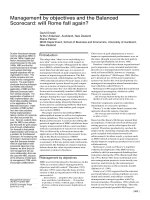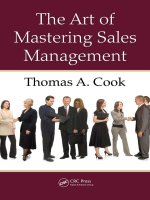mastering sales management_ 2010 by taylor and francis group, llc
Bạn đang xem bản rút gọn của tài liệu. Xem và tải ngay bản đầy đủ của tài liệu tại đây (1.81 MB, 202 trang )
The Art of
Mastering Sales
Management
The Art of
Mastering Sales
Management
Thomas A. Cook
CRC Press
Taylor & Francis Group
6000 Broken Sound Parkway NW, Suite 300
Boca Raton, FL 33487-2742
© 2010 by Taylor and Francis Group, LLC
CRC Press is an imprint of Taylor & Francis Group, an Informa business
No claim to original U.S. Government works
Printed in the United States of America on acid-free paper
10 9 8 7 6 5 4 3 2 1
International Standard Book Number: 978-1-4200-9075-8 (Hardback)
This book contains information obtained from authentic and highly regarded sources. Reasonable efforts
have been made to publish reliable data and information, but the author and publisher cannot assume
responsibility for the validity of all materials or the consequences of their use. The authors and publishers
have attempted to trace the copyright holders of all material reproduced in this publication and apologize to
copyright holders if permission to publish in this form has not been obtained. If any copyright material has
not been acknowledged please write and let us know so we may rectify in any future reprint.
Except as permitted under U.S. Copyright Law, no part of this book may be reprinted, reproduced, transmitted, or utilized in any form by any electronic, mechanical, or other means, now known or hereafter invented,
including photocopying, microfilming, and recording, or in any information storage or retrieval system,
without written permission from the publishers.
For permission to photocopy or use material electronically from this work, please access www.copyright.
com ( or contact the Copyright Clearance Center, Inc. (CCC), 222 Rosewood
Drive, Danvers, MA 01923, 978-750-8400. CCC is a not-for-profit organization that provides licenses and
registration for a variety of users. For organizations that have been granted a photocopy license by the CCC,
a separate system of payment has been arranged.
Trademark Notice: Product or corporate names may be trademarks or registered trademarks, and are used
only for identification and explanation without intent to infringe.
Library of Congress Cataloging‑in‑Publication Data
Cook, Thomas A., 1953The art of mastering sales management / Thomas A. Cook.
p. cm.
Includes bibliographical references and index.
ISBN 978-1-4200-9075-8
1. Sales management. I. Title.
HF5438.4.C666 2010
658.8’1--dc22
Visit the Taylor & Francis Web site at
and the CRC Press Web site at
2009022076
Dedicated to all the American soldiers who fight everyday to preserve the ideals
and beliefs of this nation and particularly to those who shed blood…
Irrespective of politics, sentiments, or personal positions.
God Bless Them All.
And let us be grateful for all we have.
Contents
Introduction................................................................................................... xv
Acknowledgments........................................................................................xvii
1
The Importance of Leadership in Sales Management.............................1
.
Overview......................................................................................................1
Mentoring, Coaching, Teaching, Supervising, Managing, and Leading.......3
Mentoring...........................................................................................4
.
Coaching.............................................................................................4
Teaching..............................................................................................4
Supervising..........................................................................................4
Managing............................................................................................5
Leading...............................................................................................6
.
2
Making Sure the Goals of Corporate Conform to the Sales and
Marketing Initiatives..............................................................................9
Growth.........................................................................................................9
Goals, Strategies, and Tactics. ....................................................................10
.
Follow-up..........................................................................................12
Goals.................................................................................................12
Strategies...........................................................................................13
Tactics...............................................................................................14
Managing the Four Corners of the Sales Matrix.........................................15
Manage-Up, Manage-Down, Manage-In, Manage-Out....................15
3
Globalization and Sales Management...................................................19
Globalization..............................................................................................19
Foreign Languages.............................................................................20
Diverse Cultures................................................................................21
Currency Exchange...........................................................................22
Management of Foreign Distributors and Agents..............................22
Local Marketing, Promotion, and Sales Differences..........................23
Political Risks....................................................................................24
vii
viii Contents
Economic Differentiations.................................................................24
Complicated Laws and Regulations...................................................24
Global Risk Management..................................................................25
Vast Geographic Differences..............................................................25
Major Supply Chain and Logistics Issues. .........................................25
.
Packing, Marking, and Labeling Variables........................................26
Dealing with U.S. and Foreign Customs Authorities.........................26
Compliance and Security Concerns...................................................26
Overseas Travel. ................................................................................26
.
Time Differences...............................................................................27
Domestic Sales vs. International Sales: Major Differences in
Overall Sales Management and Personnel Matters............................28
FCPA: Foreign Corrupt Practices Act................................................28
4
Know When to Be the Mother, the Father, the Brother, the Best
Friend, or the Boss—What Personality Hat to Wear?...........................31
Which Personality Hat to Wear?................................................................32
.
When to Mother?..............................................................................32
When to Father?................................................................................33
When to Be the Best Friend?.............................................................33
When to Be the “Boss”?.....................................................................33
Some Examples...........................................................................................33
5
Mentoring and Developing the Skill Sets of Your Sales Staff................41
Sales Skill Sets............................................................................................41
Sales Skills Development Strategy............................................................. 42
.
Excelling in Customer Service: Best Practices.............................................43
6
Motivational Techniques and Enhancing Bottom-Line Results...........45
Why We Need to Motivate.........................................................................45
Two Types of Motivation............................................................................45
Team Motivation........................................................................................47
7
Case Studies in Sales Management Problem Solving............................49
Case 1.........................................................................................................49
Resolution Step 1...............................................................................49
Resolution Step 2...............................................................................50
Resolution Step 3...............................................................................50
Resolution Step 4...............................................................................50
Resolution Step 5...............................................................................50
Resolution Step 6...............................................................................50
Case 2.........................................................................................................51
Resolution Step 1...............................................................................51
Resolution Step 2...............................................................................51
Contents ix
Resolution Step 3...............................................................................51
Resolution Step 4...............................................................................51
Case 3.........................................................................................................52
Case 4.........................................................................................................53
Resolution Step 1...............................................................................53
Resolution Step 2...............................................................................53
Resolution Step 3...............................................................................53
Resolution Step 4...............................................................................53
Resolution Step 5...............................................................................53
Case 5.........................................................................................................54
Case 6.........................................................................................................55
Case 7.........................................................................................................56
Resolution Step 1...............................................................................56
Resolution Step 2...............................................................................56
Pricing......................................................................................57
Competitive Service and Value-Added Deficits........................58
Lack of Qualified Closing Skills...............................................59
Poor Proposals from a “Quality Communicative”
Benchmark...............................................................................59
Lack of Quality Relationship with Buyers................................59
Not Selling to the Decision Maker...........................................60
Failure to Convince Prospect to “Buy-In”.................................61
Extraneous Issues.....................................................................62
8
The Sales Manager Daily Regimen: Time Management Excelled.........63
Time Management Overview.....................................................................63
The Visual.........................................................................................63
.
Point 1.............................................................................................. 64
Point 2.............................................................................................. 64
Point 3...............................................................................................65
Take the Initiative to Change Behavior: It Will Change the Results!......... 66
Mindset............................................................................................ 66
Organization.................................................................................... 66
Prioritization.................................................................................... 66
.
Communication................................................................................67
Daily Regimen Planner for the Sales Manager............................................67
Family...............................................................................................68
Physical Conditioning.......................................................................68
Mental Setup.....................................................................................69
Review of Long-Range Goals and Strategies......................................69
Review of Short-Term Issues (Daily Checklist and Planner)..............70
Team Contact....................................................................................71
Office Contact...................................................................................71
x Contents
Best Use of Time...............................................................................71
Lunch................................................................................................72
Afternoon Focus................................................................................72
Summary and Setup for the Next Day and Balance of Week............73
.
9
Mastering Key Skill Sets.......................................................................75
Forecasting.................................................................................................75
Information Flow..............................................................................76
Accurate Projections..........................................................................76
Unsatisfied Customers Are Clearly Not What
Anyone Wants......................................................................... 77
Angry Senior Management Is Not to Anyone’s Advantage...... 77
Communicating Precisely and Timely..................................... 77
Communications Effect Information Flow for More
Responsible Forecasting. ......................................................... 77
.
Managing and Tweaking the Forecast.............................................. 77
Interviewing...............................................................................................78
Know What Your Needs Are.............................................................78
Identify the Skill Sets of the Salesperson against Your Needs............79
Turn Over All Stones Both Inside and Outside of Company.............79
Interview as Many Candidates as Possible, after Being
Prescreened by Human Resources.....................................................79
Set a Time Frame for Interviewing and a Time Frame for
Selection and an Anticipated Start Date............................................79
Judge “Character” High on the List...................................................80
Qualify Motivational “Kick” Points, and Make Sure These Are
Doable...............................................................................................80
Call Referrals.....................................................................................80
Develop a Job Profile/Description That Is Very Specific....................81
Make Sure the Offer Is Contemporary, Competitive, with Clear
and Doable Incentives.......................................................................81
Summary in Interviewing..................................................................82
Hiring, Firing, and Maintaining................................................................82
Terminations.....................................................................................82
Hiring...............................................................................................83
.
Maintaining......................................................................................83
Security................................................................................... 84
Career. .................................................................................... 84
.
Compensation......................................................................... 84
Leading-Edge Innovation and Reinventing................................................85
.
Confrontational Management....................................................................86
Proposals That Work. .................................................................................87
.
Lead Development......................................................................................88
Contents xi
Managing the “Sales Pipeline”....................................................................88
Running Meetings......................................................................................89
Eyeball to Eyeball..............................................................................89
Conference Calling. ......................................................................... 90
.
Negotiation Is Key......................................................................................91
Strategic.............................................................................................91
Understanding What Each Side Wants....................................92
Negotiating with Leverage. ......................................................93
.
Obtaining Information: Mining...............................................94
Relationship Building...............................................................94
Developing a Strategy...............................................................96
Tactical..............................................................................................97
Making the Strategy Work.......................................................97
Determining the Place, the Time, the Players....................................98
The Place..................................................................................98
The Time..................................................................................98
The Players...............................................................................99
Executing...............................................................................100
Follow-Up..............................................................................101
Problem Solving. ......................................................................................101
.
Emotional Intelligence..............................................................................102
10 Best Practices: Sales Management Excellence.....................................107
Health......................................................................................................107
Remember Who You Are and Where You Came From.............................108
Be Consistent. ..........................................................................................108
.
Raise the Bar for Yourself.........................................................................109
.
Raise the Bar for Your Team.....................................................................109
Maintain a Mindset of Improvement and Maintain the Learning
Process...................................................................................................... 110
Manage Locally, Think Globally.............................................................. 110
.
Be Altruistic............................................................................................. 111
.
Always Lead and Set a Positive Example................................................... 111
Always Take the High Road.....................................................................112
11 Transitioning from Sales to Sales Management..................................113
Why Are You Now in Management?........................................................113
Dealing with Colleagues and Peers........................................................... 114
Being of Value.......................................................................................... 114
.
Be a “Turtle”............................................................................................. 115
xii Contents
Concluding Remarks................................................................................... 117
Appendix...................................................................................................... 119
Foreign Corrupt Practices Act (FCPA): Department of Justice Extract..... 119
Introduction....................................................................................120
Background.....................................................................................120
Enforcement....................................................................................121
Antibribery Provisions.....................................................................122
Basic Prohibition....................................................................122
Third Party Payments.............................................................124
Permissible Payments and Affirmative Defenses..............................125
.
Facilitating Payments for Routine Governmental Actions......125
Affirmative Defenses..............................................................125
Sanctions against Bribery................................................................126
.
Criminal. ...............................................................................126
.
Civil.......................................................................................126
Other Governmental Action. .................................................126
.
Private Cause of Action..........................................................127
Guidance from the Government......................................................127
Political Risk Overview............................................................................128
Political Risk Insurance Update: 2000 and Beyond.........................128
History...................................................................................128
Spread of Risk........................................................................129
Political Risk Coverages.........................................................130
ISO War Risk Exclusion.........................................................131
Trade Disruption....................................................................133
Markets..................................................................................133
Loss Control...........................................................................135
Global Risk Management.........................................................................136
Political Risk Coverage Analyzed: Ten Critical Steps for Risk
Managers.........................................................................................136
Use a Specialist to Arrange International Protection........................140
Information and Technology in Sales Management..................................142
World Trade Institute......................................................................142
Needed: Fluent Access to and Use of Sales Knowledge....................143
The Challenge of Sales Knowledge Management.............................143
Knowledge-Management Functions................................................144
Technology Solutions......................................................................144
.
Knowledge Architecture: Organizing Knowledge for Use............... 145
State of the Sales Knowledge Technology Marketplace. ..................147
.
Benefits of the Strategy....................................................................150
Making Someone Sell...............................................................................150
Thomas A. Cook
Contents xiii
ARI.................................................................................................150
Sales Management Seminar: Newly Appointed Sales Manager
Workshop Agenda.................................................................................... 151
Thomas A. Cook
Presentation for First-Time Sales Managers.............................................. 151
.
Why Are You in the Position of a Newly Appointed Sales
Manager?......................................................................................... 151
Why Have You Accepted the Position?............................................ 152
What Are Your Concerns or Fears about These New
Responsibilities?. ............................................................................. 152
.
What Does Senior Management Expect from You?......................... 152
What Are Your Expectations from This Seminar and Class?. .......... 152
.
Management vs. Leadership?........................................................... 153
Goals and Strategies........................................................................ 153
.
Execution and Consistency: Success or Failure................................ 153
Name the Major Responsibilities of a “Sales Manager”................... 153
.
What Are Transitional Issues?......................................................... 153
.
Why Do People Buy?................................................................................154
Management Qualities....................................................................154
Delegation.......................................................................................154
Potential Problem Areas. .................................................................154
.
Best Attributes of Sales Personnel....................................................154
Running of Meetings. ..................................................................... 155
.
Prospecting and Lead Generation............................................................. 155
Interviewing.................................................................................... 155
Negotiation Best Practices Outline: 10 Steps............................................156
Thomas A. Cook
Go to School...................................................................................156
.
Master This Skill Set. ......................................................................156
.
Study the Psychology of Need and People’s Behavior. ..................... 157
.
Compromise.................................................................................... 157
Create the Win-Win Scenario.......................................................... 157
Mine Heavily................................................................................... 158
Articulation Is Key.......................................................................... 158
Sell to the Decision Makers............................................................. 158
Control the Venue........................................................................... 158
Make It So It Sells Itself. ................................................................. 158
.
Closing Questions.................................................................................... 158
.
Sales Management Case Studies Workshop.............................................. 159
Basic Case Studies........................................................................... 159
Case 1.................................................................................... 159
.
Case 2.................................................................................... 159
.
xiv Contents
Case 3.................................................................................... 159
.
Case 4....................................................................................160
.
Case 5....................................................................................160
.
Case 6....................................................................................160
.
Case 7....................................................................................160
.
Case 8....................................................................................160
.
Case 9....................................................................................160
.
Case 10................................................................................... 161
Case 11................................................................................... 161
Case 12. ................................................................................. 161
.
Case 13................................................................................... 161
Case 14................................................................................... 161
Case 15................................................................................... 161
Advanced Case Studies....................................................................162
Case I.....................................................................................162
Case II....................................................................................162
Case III..................................................................................162
Case IV..................................................................................163
Case V....................................................................................163
Case VI..................................................................................163
Case VII.................................................................................163
What International Salesmen and Travelers Need to Know about U.S.
Customs (CBP).........................................................................................164
Thomas A. Cook
Index............................................................................................................169
About the Author.........................................................................................181
Introduction
Corporations have changed their marketing and selling processes to accommodate
a new world order following the stock market decline in 1999/2000 and the events
of September 11, 2001.
Globalization, customer service, leadership, lower margins, and longer and
harder working hours have become the norm.
This book will dissect the current-events issues that have changed the art of
selling and offer “hands-on” strategies, techniques, and easy execution-able tips to
higher-end sales personnel and those who manage them.
The author is a seasoned salesman, marketing tycoon, and sales manager with
numerous failures and successes to share with the reader. The experience spans
six continents, 80 countries, and 12 different business platforms and has spanned
35 years.
The focus of the book is on setting sales strategy, providing exemplary leadership, and developing skill sets to successfully manage sales personnel, team initiatives, and corporate growth plans.
The book becomes a very useful desk reference manual for sales managers in all
the aspects of managing, handling, and dealing with sales personnel issues. From
the very best of circumstances to the very worse—it is all covered in detail.
The author shows how to be creative in problem solving and offers a very direct,
no nonsense guide for getting the best from your sales people and keeping them as
long-term contributing and motivated employees.
The book concludes in setting up a daily regimen for the sales manager to keep
him or her on track on his or her responsibilities and a clear and concise direction
for success.
Thoughts to sell by…
Daring ideas are like chessmen moved forward; they may be beaten, but
they may start a winning game.
Johann Wolfgang von Goethe
xv
Acknowledgments
The American Management Association
Neil Lenok
Annette Homan
Binder Riha Associates
World Trade Institute
The World Academy
American River International
xvii
Chapter 1
The Importance of
Leadership in Sales
Management
This chapter looks at the differences between management and leadership and outlines the necessary steps to accomplish both.
Overview
◾◾ What are leadership and management?
◾◾ Can they be learned, enhanced, and mastered?
◾◾ Are they innate? Are leaders born, made, or matured?
These questions are critical in succeeding in sales and sales management!
Most business philosophies identify management as the role of supervising
employees, keeping organized, communicating effectively, and handling the various tasks to deliver the results dictated by “senior management and the company.”
Leadership is a more complex concept. I believe it is a quality that allows a
person to successfully lead a group of people into battle, effect change, modify
behavior, and raise people’s abilities to greater heights.
Are all managers leaders? Are all leaders managers? Neither is necessarily true.
Who do we know in public life in the last 75 years who were great leaders?
Winston Churchill, Franklin Roosevelt, Ronald Reagan, John Kennedy, to name
1
2 The Art of Mastering Sales Management
a few. Who were great managers? Jimmy Carter, Joe Torre, Alan Greenspan, Colin
Powell, to name a few.
Why do we see some as great managers versus others as great leaders? The difference is that those who have leadership attached to their persona were able to inspire,
motivate, and cause change in big ways. Those who were managers were successful
because they appeared organized, mature, collected, centered, and could approach
their responsibilities well.
Some characteristics of managers and leaders are similar. But the main division
comes in the ability to effect change. The leader has a following. He or she gets
people to believe and motivates them to modify behavior and produce results. The
manager manages tasks, activities, and responsibilities, hopefully well.
The military—the Department of Defense—spends millions of dollars to determine what makes good managers and leaders. It is always a controversial subject as
to whether leaders can be made and whether managers can be made.
This author has come to the following conclusions:
Leadership is innate. It can be enhanced, and it can be further developed through
experience and learning curves, but one has it from birth and develops it as
he or she matures.
Certain management qualities are innate, but most can be learned through
experience.
There are fewer leaders than managers, making good leaders harder to find.
That is why there are fewer CEOs than vice presidents and fewer business entrepreneurs than there are managers.
The expression, “Cream rises to the top,” is both true and false. It is true that
leaders rise to the occasion. But it is false in the sense that all managers will rise
to senior levels of business. Those who possess both leadership and management
qualities—in balance—will have the best opportunities for success in running
businesses and creating the most dynamic sales organizations.
I just mentioned the word “balance.” What I mean is that leadership and management skill sets are critical to a person’s success, but only when they are balanced
with each other.
We all know people who have leadership qualities but are overwhelming, sometimes even to the point of being arrogant or obnoxious. We all know good managers
who are too anal, too picayune, or even too organized. We end up having disdain
for these individuals, no matter how successful they are. But those individuals who
have leadership and management character traits and skill sets that combine the
best of both are better in leading personnel in any organization. Excessiveness in
almost anything will eventually fail.
Sales managers who work on their leadership and management skills in a
more harmonic and balanced approach will find it easier to adapt to and work
The Importance of Leadership in Sales Management 3
with others. This balance will lead to more productive activities and greater levels
of success.
Sales managers have to effect change in people. They have to encourage. They
have to promote, advocate, and endorse. They have to manage initiatives. They have
to organize individuals into teams. They have to coach and mentor.
Their best shot at getting that all done consistently and successfully is to balance
out the necessary capabilities as a good leader and manager. They will earn more
respect and find it easier to achieve results from the people who work for them.
How can we do this? In three steps:
1.Learn what you have. Identify your leadership skills and talents. Understand
your management prowess. Identify your strengths and weaknesses. This
requires a lot of introspective insight and the possibility of outside testing
and personality-revealing options. This will depend on how honest you are
with yourself and your ability “to see the forest through the trees” in your
own self-analysis.
2.Seek assistance from outside agencies. Seminars, consultants, reading,
Internet, and sales management associations are but a few of the options here.
Business schools such as the American Management Association, the World
Academy, Dale Carnegie Training, and IOMA are but a few of the very professional and competent educational options that you can turn to.
www.amanet.org
www.theworldacademy.com
www.dalecarnegie.com
www.ioma.com
3.Benchmark your initiatives. Continually work at seeing how you are progressing. Set aggressive but achievable goals, and have several independent
persons advise you on where you are at and what else needs to be done.
Many sales managers utilize professional mentors or consultants to help them
with this area of responsibility of receiving independent advice and status.
Mentoring, Coaching, Teaching,
Supervising, Managing, and Leading
Mentoring, coaching, teaching, supervising, managing, and leading are all very
interconnected and, by some definitions and practice, can all be one in the same.
They all point a person in the right direction and enable him or her to get there.
4 The Art of Mastering Sales Management
They all show someone how to do something. They all establish an action for someone to take. They all pass information and demonstrate its value.
Mentoring
The dictionary definition of mentor is “a close, trusted, experienced counselor or
guide.” In business, we think of a mentor as a person we look up to and who shows
us the way by example.
To have the nameplate “Mentor” is typically a thing to be proud of and feel
good about. It is generally all positive. To have a mentor in life and in business creates immediate and significant advantage to a person, and in sales it can mean the
difference between success and failure in certain trades and industries.
Coaching
The dictionary definition of a coach is “one who instructs or trains.” We think
mostly of coaches relative to athletics and sports (Figure 1.1). We envision the older
and larger former champion sharing his or her talent and experience to bring out
the best in us.
We envision someone championing us on to victory; picking us up when we
are down and motivating us to try harder; sharing with us his or her strengths and
making them work for us.
This is all and every part of what coaches do for us in business and in sales
management. And they are often inspiring.
Teaching
The dictionary defines a teacher as “one who shows, guides, and instructs.” We
think of teachers as individuals who talk to us about specific subjects and the necessary skill sets we need to grow and succeed.
Teaching is generally accomplished in a formal and structured environment.
As sales managers, we need to teach some very specific skill sets and capabilities
(Figure 1.2).
Supervising
The dictionary tells us that supervising involves direction and oversight. Sales managers must direct and oversee the sales personnel that report to them.
We envision supervisors wearing visors and shirt cuffs, standing over us and
annunciating orders and shouting commands.
As managers, we do have to exercise supervisory actions, which can be micromanaging our staff on a transactional or specific subject-matter basis. “Supervision”
The Importance of Leadership in Sales Management 5
Figure 1.1 Coaching in athletics is like coaching in management.
is usually narrower in scope then overall “management,” and in many organizations
it is a step just before being elevated to manager.
Managing
A manager is defined as one who trains, handles, directs, plans, organizes, coordinates, etc. Many also expand this definition to include the additional responsibility
of obtaining certain “results.”
Managing is clearly a larger and more pronounced theater of responsibility than supervising. It greatly increases and enhances the overall scope that the
“supervisor” is now held accountable for. Fostering growth is part of management
(Figure 1.3).
Management at this level is involved with making money and profits for the
company. In sales management, the central theme is an array of skill sets and
responsibilities to meet the goals of the company in account retention, new business development, and profitability.
6 The Art of Mastering Sales Management
Figure 1.2 Teaching computer skill sets.
Leading
Leadership is a much harder trait to understand. The dictionary tells us that it is “to
cause to go with oneself, to convey and to guide, to provide direction.”
The author’s definition of leadership, particularly in business and in sales, is for
an individual to create a persona that changes behavior in a direction that causes
goals, plans, and deliverables to be met.
Of all the skills—mentoring, coaching, teaching, supervising, managing, and
leading—leading is the most difficult to achieve. In this book, we will discuss this
subject in greater detail.
Leadership has certain innate qualities that give a person this capability. It is
the hardest to achieve because it is more difficult not only to learn, but to put to
successful practice. One could be a good supervisor, manager, or teacher and not
necessarily be a good leader.
Leadership makes change happen, and change is one of the hardest human
qualities to come by. Good leaders can enhance and grow established skill sets in
any area and hone their leadership qualities with training, experience, and continual information flow.
Information flow through informal and formal training, seminar participation, Web-site utilization, and reading of periodicals is your best option. Spending









